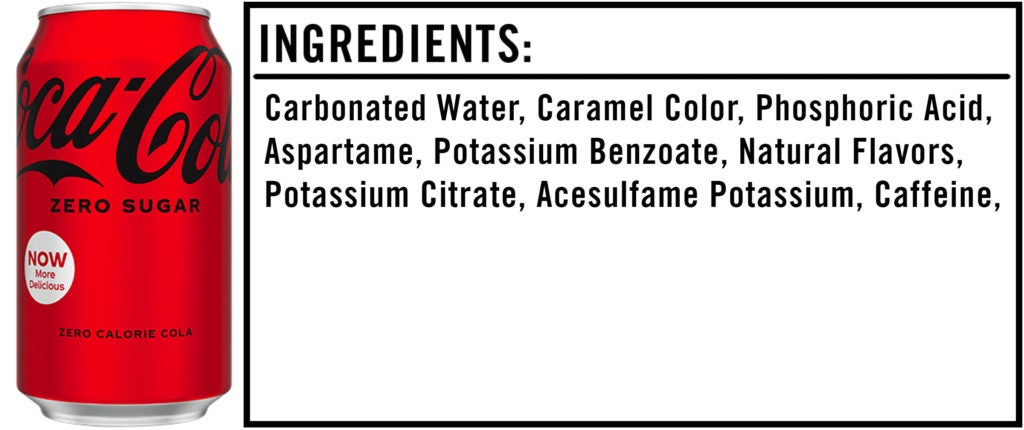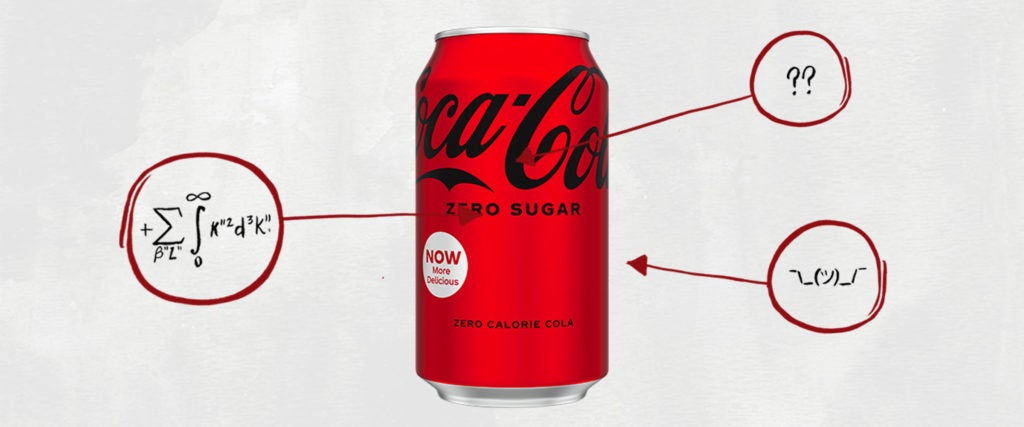The 2021 hullabaloo surrounding the release of “New” Coke Zero Sugar is accompanied by echoes of a product introduction that disoriented the beverage industry in 1985, when New Coke was introduced, thereby irritating all of the people who had stopped drinking Coca-Cola in the first place.
While Coke Zero Sugar is certainly popular, it isn’t the flagship product of the company. More to the point, its flavor had been tinkered with before in 2017 — when the name of the drink was simultaneously lengthened from “Coke Zero” to “Coke Zero Sugar” — and sales of sugar-free sodas aren’t contentious enough to prompt a high-profile soft-drink executive to publicly proclaim that “the other guy blinked” in the wake of this latest flavor modification. Not that a blink or two would do much damage to Coca-Cola in this case; in terms of total market share within the cola category, Coke Zero Sugar presently outsells Pepsi Sugar Free by a 20-to-1 margin.
The Coca-Cola Company is predicting big things for its updated zero-calorie colossus, although its reported changes to Coke Zero Sugar merely tweaked the ratios of certain ingredients within the beverage without adding anything new to the mix.
What are those ingredients exactly? Let’s take a deep dive.

Ingredients
Carbonated Water: This is simply regular purified water, with pressurized carbon dioxide gas running through it. Studies have shown that there is no obvious detriment to consuming carbonated water as long as nothing else has been added to it. However, plenty has been added to this particular batch of carbonated water, so we’ll need to keep this in mind later on.
Caramel Color: Made by heating corn or corn sugar and other carbohydrates, caramel coloring has a controversial byproduct called 4-methylimidazole (4-MEI): A 2007 study found that mice fed a diet of 4-MEI developed cancerous lung tumors as a result. The FDA quickly pushed back, noting that a human would have to consume more than 1,000 cans of soft drinks every day for two years to reach comparable levels of 4-MEI.
A 2015 study argued that levels of 4-MEI are high enough in soda, and consumed in sufficient quantities by Americans to increase the risk of developing cancer in rare cases. However, the same study assessed that the likely number of cancer cases attributable to Coca-Cola — which had the lowest levels of 4-MEI contained in all the products tested — was 76 over a 70-year period in California, in comparison to Pepsi’s 1,004 and Malta Goya’s 5,011.
Keep in mind, all of these numbers are speculative estimates, and the official story was reaffirmed in 2018 that caramel color would have to be ingested in unattainable quantities before humans would realize any cancerous consequences through its use.
Phosphoric Acid: Phosphoric acid is what provides carbonated beverages with the bulk of their acidity. It fills the dual role of adding tartness to the flavor of soda, and also acts as a preservative to prevent the growth of mold and bacteria. This latter problem is common in sugary solutions, but since this is Coke Zero Sugar, that problem is mitigated. For most people, the worst thing this might do is cause you some mild heartburn, but if you start drinking the equivalent of eight cans daily, you potentially run the risk of depleting your body’s optimal calcium level.
Aspartame: Aspartame is an artificial sweetener made primarily out of two amino acids (the building blocks of protein) — aspartic acid and phenylalanine. Because aspartame is about 200 times sweeter than sugar, much less of it is needed to achieve the desired sweetness .
A single can of Coke Zero Sugar contains 87 milligrams of aspartame, meaning that an average person would have to consume about 30 cans of soda each day to surpass the European Food Safety Authority’s recommended limit for aspartame consumption, and 36 cans to exceed the FDA’s proposed limit. By comparison, the FDA places a limit on sugar intake at 10 percent of daily calories consumed, meaning that you would exceed the FDA recommendation for sugar intake, regardless of your weight, simply by drinking two cans of regular Coca-Cola.
Multiple studies have demonstrated that replacement of sugary sodas with artificially sweetened, non-caloric sodas have resulted in weight loss in subjects, with one study even demonstrating that consumers of artificially sweetened drinks outperformed consumers of regular water with respect to weight loss.
While there are long-term observational studies that examined the consumption of artificially sweetened beverages over a period of several years and found that the group that consumed the most artificially sweetened beverages gained the most weight, analysis of these studies has posed the possibility that individuals struggling with being overweight are most likely to turn to artificially sweetened beverages, presenting what may be a classic case of how correlation doesn’t necessarily imply causation.
Potassium Benzoate: Potassium benzoate is a chemical preservative that blocks the growth of bacteria, yeast and mold. It’s a frequent substitute for sodium benzoate whenever the sodium content of a product needs to be reduced.
Potassium benzoate has the odd quirk of being generally healthy except when it’s combined with a source of vitamin C, and then has heat and light added to it. This mixture has been known to cause the formation of benzene, which has the potential to cause cancer. Otherwise, the consumption of potassium benzoate is considered to be safe; to surpass the recommended daily intake level of potassium benzoate, an average person would have to consume more than a full two-liter bottle of soda.
Natural Flavors: Natural flavors are quite literally flavors derived from an actual food source — i.e., strawberry flavoring taken from a real strawberry. The natural flavors used in Coca-Cola’s soft drinks remain one of the best-kept secrets in the food and beverage industry, right next to the Colonel’s secret recipe. This is a protection provided by the FDA that enables companies to protect their recipes from copying, the results of which would permit anyone on the street to replicate Coca-Cola’s recipes and render its brand valueless.
Despite the veil of secrecy offered by these government protections, it can be reasonably assumed that coca leaves and kola nuts are two of the flavors subsumed beneath the “natural flavors” categorization.
Potassium Citrate: Potassium citrate has the distinction of being legitimate medicine, used for the purpose of making urine less acidic, and helping people get rid of kidney stones. Seriously, you can purchase this potassium salt as a straight-up supplement for this very purpose, so don’t ever let anyone tell you Coke Zero Sugar doesn’t serve a medicinal purpose.
Acesulfame Potassium: This is an artificial sweetener that remains stable even when it’s heated, which is why it’s a popular inclusion in low-calorie baked goods. Studies using acesulfame potassium haven’t found it to increase blood sugar or insulin, and it’s considered safe provided your consumption of it doesn’t exceed 23 one-gram packets in a single day.
Caffeine: Caffeine is the world’s favorite legal stimulant, and several multi-billion-dollar beverage empires have been built on its powdery back. Its effects are undeniable, as energy drink companies have capitalized on its strength to carve out a $13 billion industry, and supplement companies use it to make you feel like their workout products are doing more for you than they really are. Realistically speaking, the caffeine content of the new Coke Zero Sugar weighs in at a relatively tame 34 milligrams per 12-ounce can (2.8 milligrams per ounce), which is a far cry from the caffeine content of a Red Bull (8.5 milligrams per ounce) or an average cup of Starbucks coffee (nearly 20 milligrams per ounce).
The Takeaway
Is Coke Zero Sugar technically good for you? Almost certainly not. Few food and beverage items requiring that much processing could ever be objectively classified as healthy. But it’s not a big batch of poison either. If you need to cut calories, and you’re prone to indulge in sugary colas, drinking Coke Zero Sugar is an attractive step toward reducing your caloric intake in one of the areas where much of the high-calorie damage is accumulated.
When you get right down to it, everything you eat is bad for you, even when it’s not. We’ve mentioned some obvious safety concerns for folks who might drink 30 cans of soda per day — and consuming 30 of almost anything a day (pizza slices, cookies, cupcakes, etc.) is also likely to cause you some problems. But life is too short to live in fear of a zero-calorie cola. So if the mood strikes you, drink responsibly, and have a Coke Zero Sugar and a smile.

